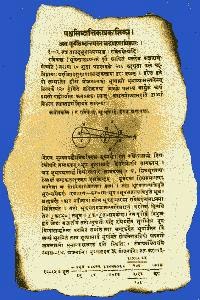Bridal Mysticism is walking with Universal Love, embracing Nature in her beauty and humanity in its entirety
Friday, February 27, 2015
Astronomy of Ancient India
Early Indian Astronomy
The practices of astronomy and astrology in ancient India had their roots almost four thousand years ago. Much of what we know about Indian astronomy comes from the Sanskrit sacred books called the Vedas. These religious texts were a series of hymns composed over several hundred years, and offer intriguing insights into the way Indians of the time viewed the sky. As in most ancient cultures, events in the heavens were believed to have direct effects on people. The practice of astrology, of divining a person's future based on physical phenomena, was a driving force in the advancement of astronomy as a science.
In the Veda texts, the gods were called Devas, which means 'bright' and refers to the luminous nature of the sun and stars. The Sun, comets, the sky, dawn, and the horizon were all deified based on their attributes. To the ancient Indians, the horizon held an immense amount of mystique: it was there that the question 'Will the sun rise again?' was answered every day. A beautiful verse from a Veda mentioning the Indian affinity for dawn says:
'Thou art a blessing when thou art near
Raise up wealth to the worshipper, thou mighty Dawn
Shine for us with thy best rays, thou bright Dawn
Thou daughter of the sky, thou high-born Dawn.'
The earliest Veda text mentioning astronomy is called the Rig Veda, and was written around 2000 B.C. At that time, the earth was considered to be a shell supported by elephants, which represented strength, and were themselves supported by a tortoise, representing infinite slowness.
Indian Astronomy in the First Millenium
As time progressed, Indian astronomy became more scientific and less spiritual. Beginning in the first century, it seems clear that Indian astronomers recognized that the stars are the same as the Sun, only farther away. Verses mention that the night sky is full of suns, and that when our Sun goes below the horizon, a thousand suns take its place. This is an incredible scientific leap in thought. The Earth was at this time considered to be spherical, and various astronomers attempted to measure its circumference. Interestingly enough, the Sun was widely believed to be the center of the universe, an idea which pre-dates western science (with the exception of a few Greek believers) by about 1100 years. However, this idea may be much older: vague references to the sun being in the center of the universe exist in Vedic writings from as early as 3000 B.C.
In the 5th century, a great Indian astronomer and mathematician named Aryabhatta advanced this heliocentric theory and also discussed his idea that the Sun is the source of moonlight. He also studied how to forecast eclipses (see photo below). His books and others were translated into Latin in the 13th century, and profoundly influenced European mathematicians and astronomers.
Several Indian scientists of the 6th century also were the first to advance the idea of gravity. They noticed that a special force keeps objects stuck to the earth, and hypothesized that the same force might be responsible for holding heavenly bodies in their place. The idea pre-dates Newton's conception of gravity by about 1100 years.
Tuesday, February 17, 2015
Chyuthi Samskaram
Chyuthi is Orbital Eccentricity. If the motion of the planet is circular, there
wont be any eccentricity. As it is elliptical, eccentricty has to be computed.
Its values range from 0 to 1 at Ellipse, 0 at Circle and 1 at Parabola ! Chyuthi Samskaram
in Indian Astronomy means to compute the eccentricity of the planet and reduce the Mean Longitude of the Planet to its Heliocentric Longitude ( Vikshepa Vritteeya Manda Sphuta ).
in Indian Astronomy means to compute the eccentricity of the planet and reduce the Mean Longitude of the Planet to its Heliocentric Longitude ( Vikshepa Vritteeya Manda Sphuta ).
Monday, February 16, 2015
Happy Siva Ratri !
Happy Siva Ratri !
The Night of Siva occurs when the Moon is in between 156 and 168 degrees from the Sun ( Chaturdasi) in the lunar month of Maagha, in the Waning Moon Fortnight ( Krishna Paksha ).
This is a very sacred day for the Eternians.
Esoteric, scientifc aspects of this Grand Night,
vIdeos and photos of the famous Aluva Siva Ratri at http://www.guruvayur4u.com/html/sivaratri.htm
Thursday, February 12, 2015
Wednesday, February 11, 2015
Subscribe to:
Comments (Atom)







